Critical Appraisal of Qualitative Study: Worksheet and Analysis
VerifiedAdded on 2022/09/16
|7
|2623
|15
Homework Assignment
AI Summary
This assignment presents a critical appraisal of a qualitative research study focusing on the benefits of Asian music therapy student peer groups. The student meticulously evaluates the study's rationale, methodology, and findings using a structured worksheet. The analysis encompasses ontological, epistemological, methodological, and ethical considerations, assessing the congruity between the research question, philosophical perspective, and methods. The appraisal delves into the study's rigor, trustworthiness, data collection and analysis techniques, and the representation of participants' voices. The student examines the findings, their credibility, and the theoretical concepts presented, while also identifying the study's limitations and their impact on the overall quality of the results. The assignment demonstrates an understanding of qualitative research principles and provides a comprehensive evaluation of the chosen study.
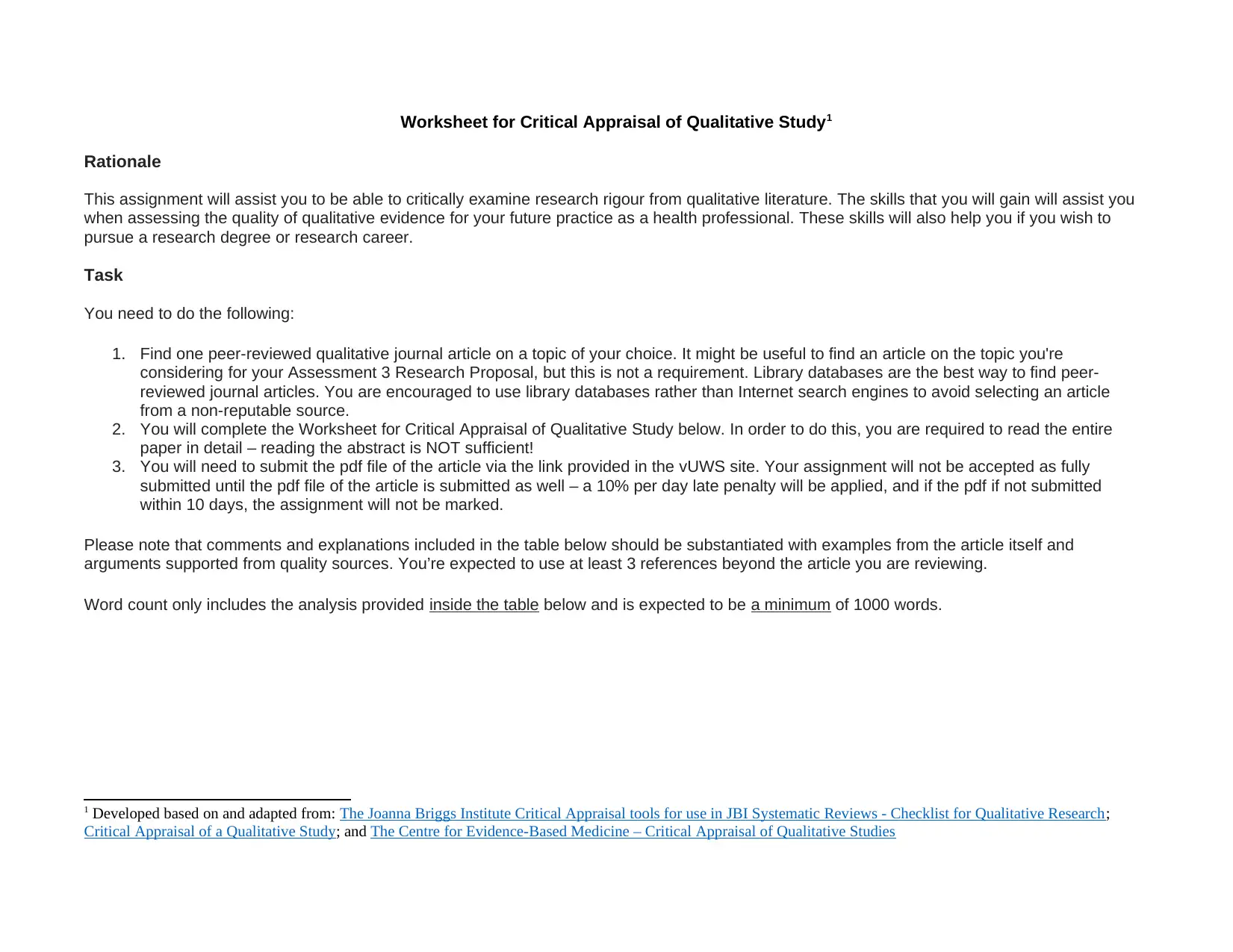
Worksheet for Critical Appraisal of Qualitative Study1
Rationale
This assignment will assist you to be able to critically examine research rigour from qualitative literature. The skills that you will gain will assist you
when assessing the quality of qualitative evidence for your future practice as a health professional. These skills will also help you if you wish to
pursue a research degree or research career.
Task
You need to do the following:
1. Find one peer-reviewed qualitative journal article on a topic of your choice. It might be useful to find an article on the topic you're
considering for your Assessment 3 Research Proposal, but this is not a requirement. Library databases are the best way to find peer-
reviewed journal articles. You are encouraged to use library databases rather than Internet search engines to avoid selecting an article
from a non-reputable source.
2. You will complete the Worksheet for Critical Appraisal of Qualitative Study below. In order to do this, you are required to read the entire
paper in detail – reading the abstract is NOT sufficient!
3. You will need to submit the pdf file of the article via the link provided in the vUWS site. Your assignment will not be accepted as fully
submitted until the pdf file of the article is submitted as well – a 10% per day late penalty will be applied, and if the pdf if not submitted
within 10 days, the assignment will not be marked.
Please note that comments and explanations included in the table below should be substantiated with examples from the article itself and
arguments supported from quality sources. You’re expected to use at least 3 references beyond the article you are reviewing.
Word count only includes the analysis provided inside the table below and is expected to be a minimum of 1000 words.
1 Developed based on and adapted from: The Joanna Briggs Institute Critical Appraisal tools for use in JBI Systematic Reviews - Checklist for Qualitative Research;
Critical Appraisal of a Qualitative Study; and The Centre for Evidence-Based Medicine – Critical Appraisal of Qualitative Studies
Rationale
This assignment will assist you to be able to critically examine research rigour from qualitative literature. The skills that you will gain will assist you
when assessing the quality of qualitative evidence for your future practice as a health professional. These skills will also help you if you wish to
pursue a research degree or research career.
Task
You need to do the following:
1. Find one peer-reviewed qualitative journal article on a topic of your choice. It might be useful to find an article on the topic you're
considering for your Assessment 3 Research Proposal, but this is not a requirement. Library databases are the best way to find peer-
reviewed journal articles. You are encouraged to use library databases rather than Internet search engines to avoid selecting an article
from a non-reputable source.
2. You will complete the Worksheet for Critical Appraisal of Qualitative Study below. In order to do this, you are required to read the entire
paper in detail – reading the abstract is NOT sufficient!
3. You will need to submit the pdf file of the article via the link provided in the vUWS site. Your assignment will not be accepted as fully
submitted until the pdf file of the article is submitted as well – a 10% per day late penalty will be applied, and if the pdf if not submitted
within 10 days, the assignment will not be marked.
Please note that comments and explanations included in the table below should be substantiated with examples from the article itself and
arguments supported from quality sources. You’re expected to use at least 3 references beyond the article you are reviewing.
Word count only includes the analysis provided inside the table below and is expected to be a minimum of 1000 words.
1 Developed based on and adapted from: The Joanna Briggs Institute Critical Appraisal tools for use in JBI Systematic Reviews - Checklist for Qualitative Research;
Critical Appraisal of a Qualitative Study; and The Centre for Evidence-Based Medicine – Critical Appraisal of Qualitative Studies
Paraphrase This Document
Need a fresh take? Get an instant paraphrase of this document with our AI Paraphraser
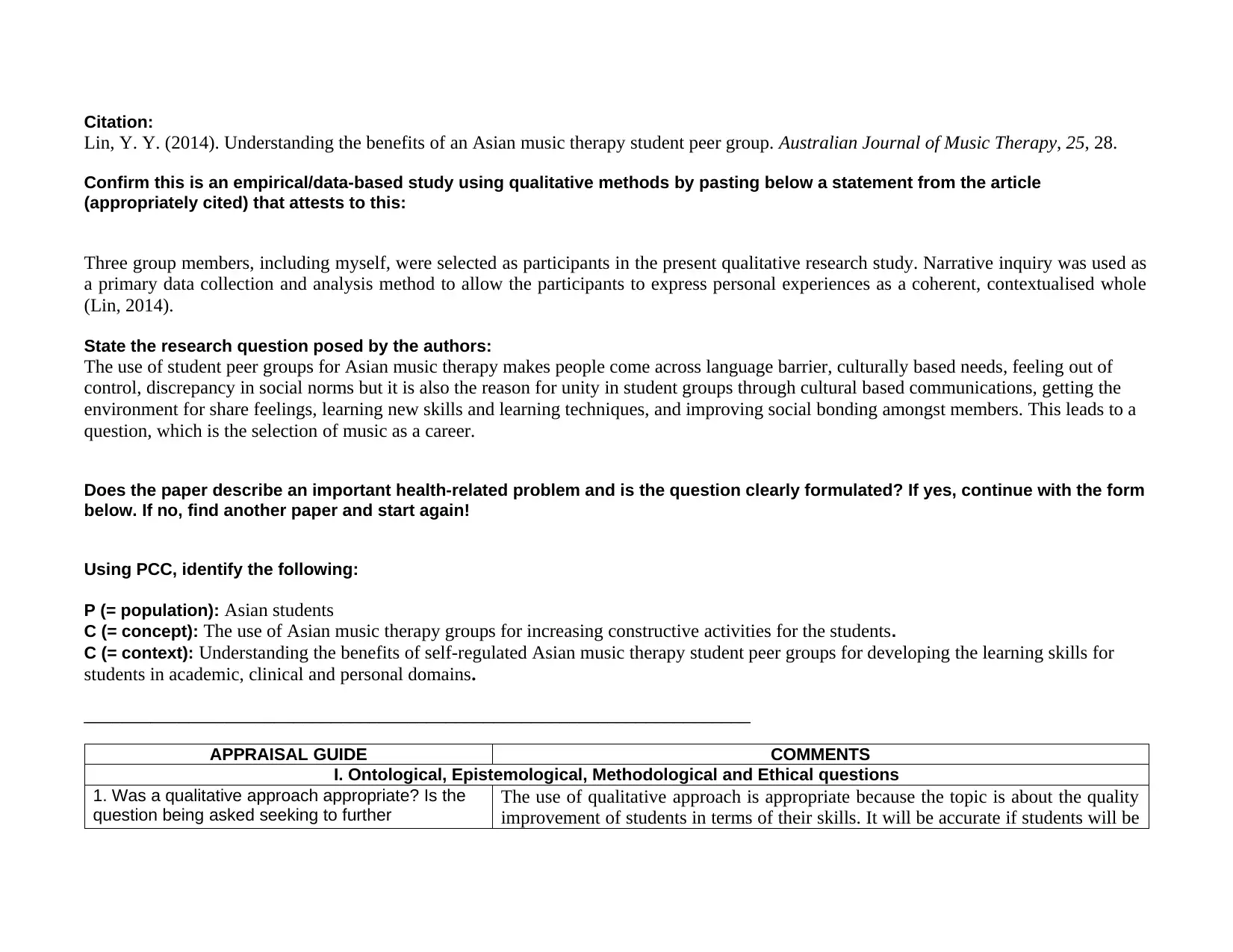
Citation:
Lin, Y. Y. (2014). Understanding the benefits of an Asian music therapy student peer group. Australian Journal of Music Therapy, 25, 28.
Confirm this is an empirical/data-based study using qualitative methods by pasting below a statement from the article
(appropriately cited) that attests to this:
Three group members, including myself, were selected as participants in the present qualitative research study. Narrative inquiry was used as
a primary data collection and analysis method to allow the participants to express personal experiences as a coherent, contextualised whole
(Lin, 2014).
State the research question posed by the authors:
The use of student peer groups for Asian music therapy makes people come across language barrier, culturally based needs, feeling out of
control, discrepancy in social norms but it is also the reason for unity in student groups through cultural based communications, getting the
environment for share feelings, learning new skills and learning techniques, and improving social bonding amongst members. This leads to a
question, which is the selection of music as a career.
Does the paper describe an important health-related problem and is the question clearly formulated? If yes, continue with the form
below. If no, find another paper and start again!
Using PCC, identify the following:
P (= population): Asian students
C (= concept): The use of Asian music therapy groups for increasing constructive activities for the students.
C (= context): Understanding the benefits of self-regulated Asian music therapy student peer groups for developing the learning skills for
students in academic, clinical and personal domains.
______________________________________________________________________
APPRAISAL GUIDE COMMENTS
I. Ontological, Epistemological, Methodological and Ethical questions
1. Was a qualitative approach appropriate? Is the
question being asked seeking to further
The use of qualitative approach is appropriate because the topic is about the quality
improvement of students in terms of their skills. It will be accurate if students will be
Lin, Y. Y. (2014). Understanding the benefits of an Asian music therapy student peer group. Australian Journal of Music Therapy, 25, 28.
Confirm this is an empirical/data-based study using qualitative methods by pasting below a statement from the article
(appropriately cited) that attests to this:
Three group members, including myself, were selected as participants in the present qualitative research study. Narrative inquiry was used as
a primary data collection and analysis method to allow the participants to express personal experiences as a coherent, contextualised whole
(Lin, 2014).
State the research question posed by the authors:
The use of student peer groups for Asian music therapy makes people come across language barrier, culturally based needs, feeling out of
control, discrepancy in social norms but it is also the reason for unity in student groups through cultural based communications, getting the
environment for share feelings, learning new skills and learning techniques, and improving social bonding amongst members. This leads to a
question, which is the selection of music as a career.
Does the paper describe an important health-related problem and is the question clearly formulated? If yes, continue with the form
below. If no, find another paper and start again!
Using PCC, identify the following:
P (= population): Asian students
C (= concept): The use of Asian music therapy groups for increasing constructive activities for the students.
C (= context): Understanding the benefits of self-regulated Asian music therapy student peer groups for developing the learning skills for
students in academic, clinical and personal domains.
______________________________________________________________________
APPRAISAL GUIDE COMMENTS
I. Ontological, Epistemological, Methodological and Ethical questions
1. Was a qualitative approach appropriate? Is the
question being asked seeking to further
The use of qualitative approach is appropriate because the topic is about the quality
improvement of students in terms of their skills. It will be accurate if students will be
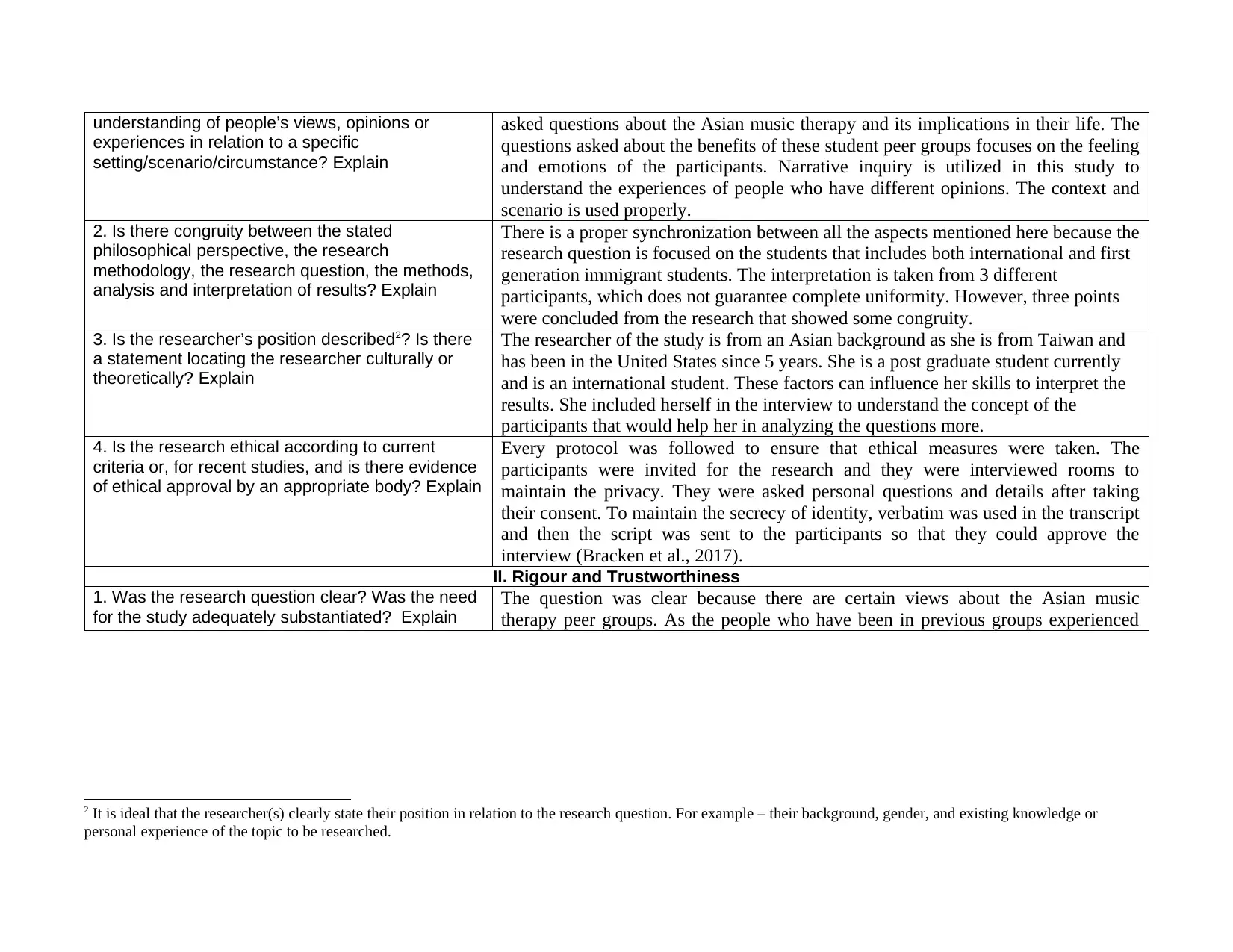
understanding of people’s views, opinions or
experiences in relation to a specific
setting/scenario/circumstance? Explain
asked questions about the Asian music therapy and its implications in their life. The
questions asked about the benefits of these student peer groups focuses on the feeling
and emotions of the participants. Narrative inquiry is utilized in this study to
understand the experiences of people who have different opinions. The context and
scenario is used properly.
2. Is there congruity between the stated
philosophical perspective, the research
methodology, the research question, the methods,
analysis and interpretation of results? Explain
There is a proper synchronization between all the aspects mentioned here because the
research question is focused on the students that includes both international and first
generation immigrant students. The interpretation is taken from 3 different
participants, which does not guarantee complete uniformity. However, three points
were concluded from the research that showed some congruity.
3. Is the researcher’s position described2? Is there
a statement locating the researcher culturally or
theoretically? Explain
The researcher of the study is from an Asian background as she is from Taiwan and
has been in the United States since 5 years. She is a post graduate student currently
and is an international student. These factors can influence her skills to interpret the
results. She included herself in the interview to understand the concept of the
participants that would help her in analyzing the questions more.
4. Is the research ethical according to current
criteria or, for recent studies, and is there evidence
of ethical approval by an appropriate body? Explain
Every protocol was followed to ensure that ethical measures were taken. The
participants were invited for the research and they were interviewed rooms to
maintain the privacy. They were asked personal questions and details after taking
their consent. To maintain the secrecy of identity, verbatim was used in the transcript
and then the script was sent to the participants so that they could approve the
interview (Bracken et al., 2017).
II. Rigour and Trustworthiness
1. Was the research question clear? Was the need
for the study adequately substantiated? Explain
The question was clear because there are certain views about the Asian music
therapy peer groups. As the people who have been in previous groups experienced
2 It is ideal that the researcher(s) clearly state their position in relation to the research question. For example – their background, gender, and existing knowledge or
personal experience of the topic to be researched.
experiences in relation to a specific
setting/scenario/circumstance? Explain
asked questions about the Asian music therapy and its implications in their life. The
questions asked about the benefits of these student peer groups focuses on the feeling
and emotions of the participants. Narrative inquiry is utilized in this study to
understand the experiences of people who have different opinions. The context and
scenario is used properly.
2. Is there congruity between the stated
philosophical perspective, the research
methodology, the research question, the methods,
analysis and interpretation of results? Explain
There is a proper synchronization between all the aspects mentioned here because the
research question is focused on the students that includes both international and first
generation immigrant students. The interpretation is taken from 3 different
participants, which does not guarantee complete uniformity. However, three points
were concluded from the research that showed some congruity.
3. Is the researcher’s position described2? Is there
a statement locating the researcher culturally or
theoretically? Explain
The researcher of the study is from an Asian background as she is from Taiwan and
has been in the United States since 5 years. She is a post graduate student currently
and is an international student. These factors can influence her skills to interpret the
results. She included herself in the interview to understand the concept of the
participants that would help her in analyzing the questions more.
4. Is the research ethical according to current
criteria or, for recent studies, and is there evidence
of ethical approval by an appropriate body? Explain
Every protocol was followed to ensure that ethical measures were taken. The
participants were invited for the research and they were interviewed rooms to
maintain the privacy. They were asked personal questions and details after taking
their consent. To maintain the secrecy of identity, verbatim was used in the transcript
and then the script was sent to the participants so that they could approve the
interview (Bracken et al., 2017).
II. Rigour and Trustworthiness
1. Was the research question clear? Was the need
for the study adequately substantiated? Explain
The question was clear because there are certain views about the Asian music
therapy peer groups. As the people who have been in previous groups experienced
2 It is ideal that the researcher(s) clearly state their position in relation to the research question. For example – their background, gender, and existing knowledge or
personal experience of the topic to be researched.
⊘ This is a preview!⊘
Do you want full access?
Subscribe today to unlock all pages.

Trusted by 1+ million students worldwide
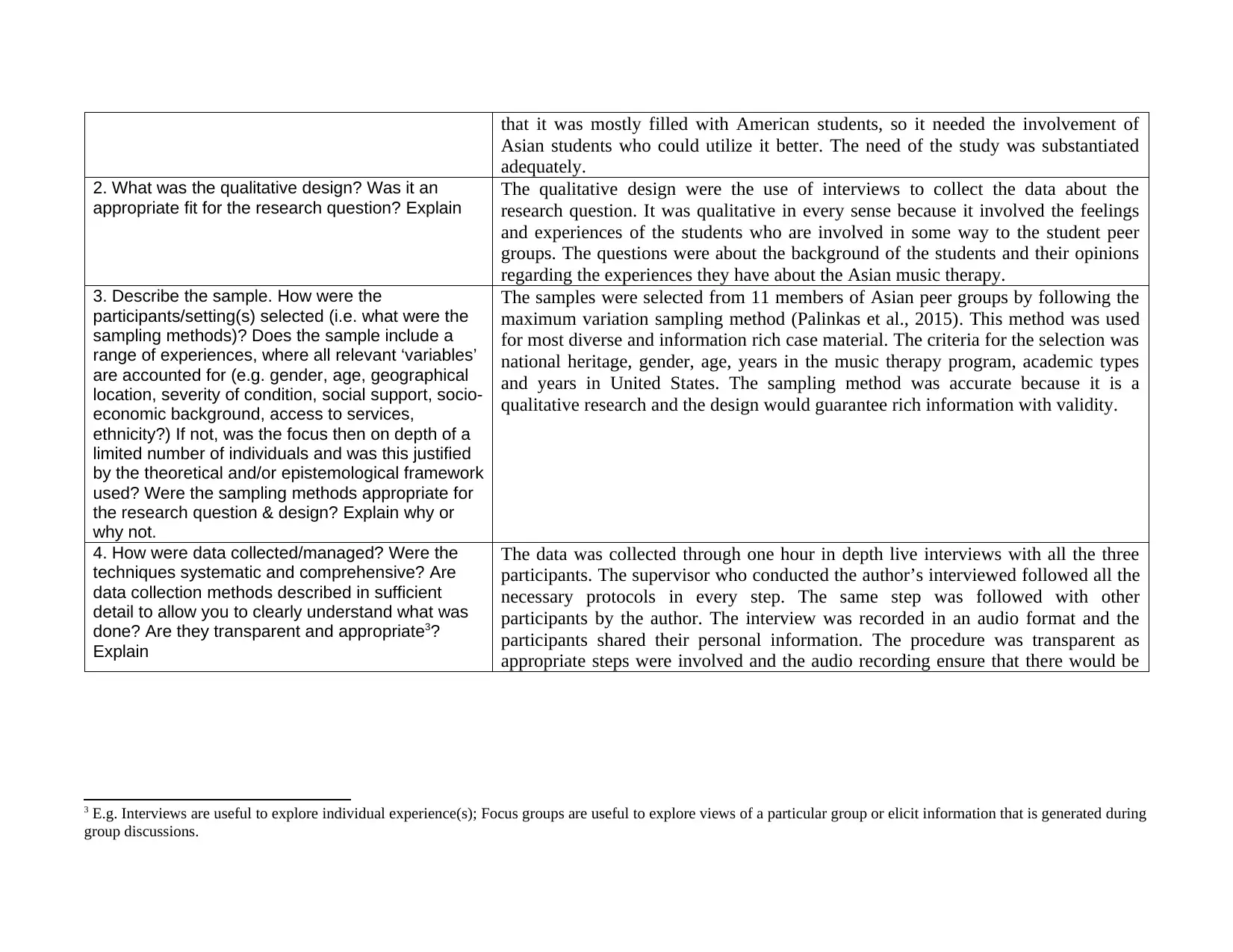
that it was mostly filled with American students, so it needed the involvement of
Asian students who could utilize it better. The need of the study was substantiated
adequately.
2. What was the qualitative design? Was it an
appropriate fit for the research question? Explain
The qualitative design were the use of interviews to collect the data about the
research question. It was qualitative in every sense because it involved the feelings
and experiences of the students who are involved in some way to the student peer
groups. The questions were about the background of the students and their opinions
regarding the experiences they have about the Asian music therapy.
3. Describe the sample. How were the
participants/setting(s) selected (i.e. what were the
sampling methods)? Does the sample include a
range of experiences, where all relevant ‘variables’
are accounted for (e.g. gender, age, geographical
location, severity of condition, social support, socio-
economic background, access to services,
ethnicity?) If not, was the focus then on depth of a
limited number of individuals and was this justified
by the theoretical and/or epistemological framework
used? Were the sampling methods appropriate for
the research question & design? Explain why or
why not.
The samples were selected from 11 members of Asian peer groups by following the
maximum variation sampling method (Palinkas et al., 2015). This method was used
for most diverse and information rich case material. The criteria for the selection was
national heritage, gender, age, years in the music therapy program, academic types
and years in United States. The sampling method was accurate because it is a
qualitative research and the design would guarantee rich information with validity.
4. How were data collected/managed? Were the
techniques systematic and comprehensive? Are
data collection methods described in sufficient
detail to allow you to clearly understand what was
done? Are they transparent and appropriate3?
Explain
The data was collected through one hour in depth live interviews with all the three
participants. The supervisor who conducted the author’s interviewed followed all the
necessary protocols in every step. The same step was followed with other
participants by the author. The interview was recorded in an audio format and the
participants shared their personal information. The procedure was transparent as
appropriate steps were involved and the audio recording ensure that there would be
3 E.g. Interviews are useful to explore individual experience(s); Focus groups are useful to explore views of a particular group or elicit information that is generated during
group discussions.
Asian students who could utilize it better. The need of the study was substantiated
adequately.
2. What was the qualitative design? Was it an
appropriate fit for the research question? Explain
The qualitative design were the use of interviews to collect the data about the
research question. It was qualitative in every sense because it involved the feelings
and experiences of the students who are involved in some way to the student peer
groups. The questions were about the background of the students and their opinions
regarding the experiences they have about the Asian music therapy.
3. Describe the sample. How were the
participants/setting(s) selected (i.e. what were the
sampling methods)? Does the sample include a
range of experiences, where all relevant ‘variables’
are accounted for (e.g. gender, age, geographical
location, severity of condition, social support, socio-
economic background, access to services,
ethnicity?) If not, was the focus then on depth of a
limited number of individuals and was this justified
by the theoretical and/or epistemological framework
used? Were the sampling methods appropriate for
the research question & design? Explain why or
why not.
The samples were selected from 11 members of Asian peer groups by following the
maximum variation sampling method (Palinkas et al., 2015). This method was used
for most diverse and information rich case material. The criteria for the selection was
national heritage, gender, age, years in the music therapy program, academic types
and years in United States. The sampling method was accurate because it is a
qualitative research and the design would guarantee rich information with validity.
4. How were data collected/managed? Were the
techniques systematic and comprehensive? Are
data collection methods described in sufficient
detail to allow you to clearly understand what was
done? Are they transparent and appropriate3?
Explain
The data was collected through one hour in depth live interviews with all the three
participants. The supervisor who conducted the author’s interviewed followed all the
necessary protocols in every step. The same step was followed with other
participants by the author. The interview was recorded in an audio format and the
participants shared their personal information. The procedure was transparent as
appropriate steps were involved and the audio recording ensure that there would be
3 E.g. Interviews are useful to explore individual experience(s); Focus groups are useful to explore views of a particular group or elicit information that is generated during
group discussions.
Paraphrase This Document
Need a fresh take? Get an instant paraphrase of this document with our AI Paraphraser
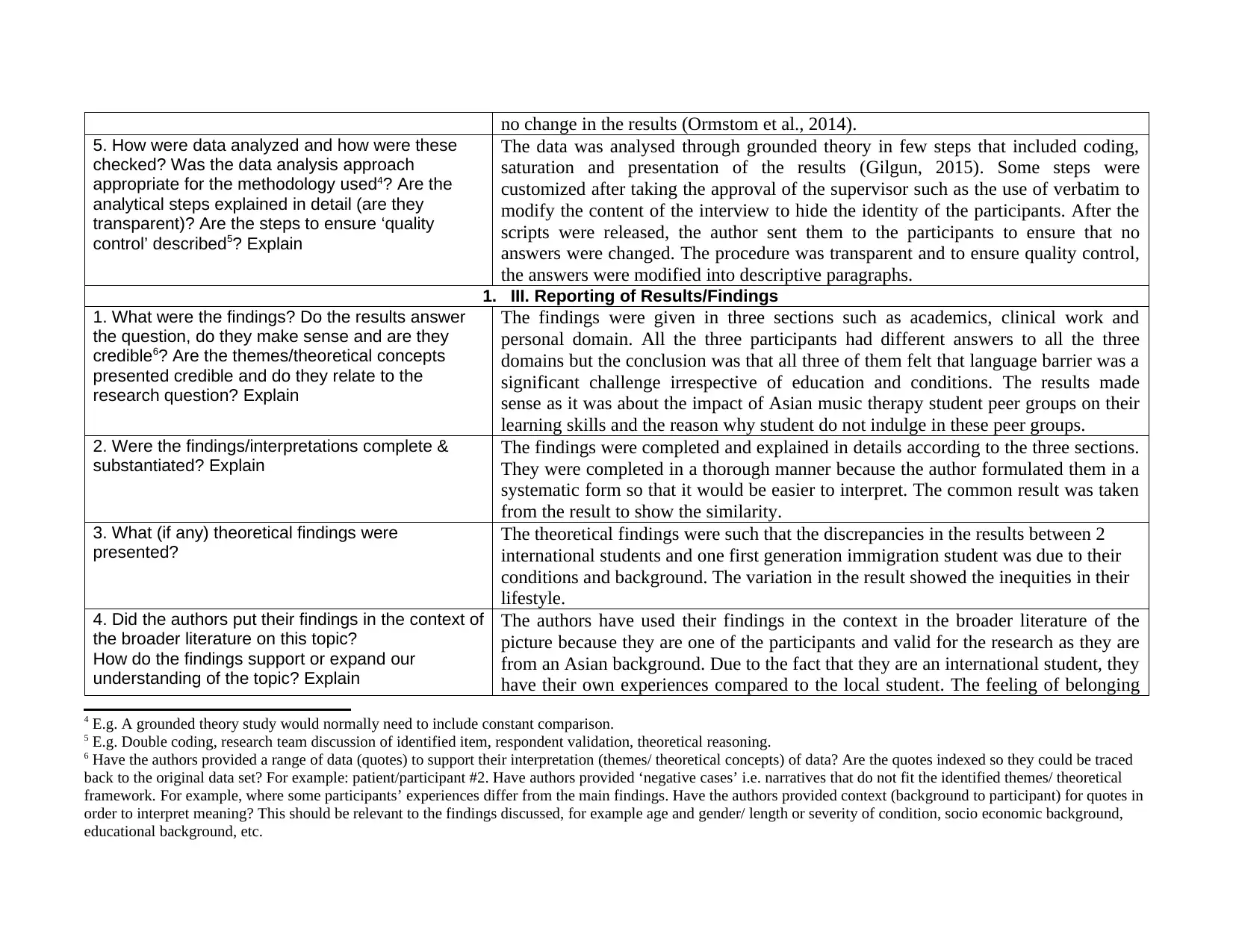
no change in the results (Ormstom et al., 2014).
5. How were data analyzed and how were these
checked? Was the data analysis approach
appropriate for the methodology used4? Are the
analytical steps explained in detail (are they
transparent)? Are the steps to ensure ‘quality
control’ described5? Explain
The data was analysed through grounded theory in few steps that included coding,
saturation and presentation of the results (Gilgun, 2015). Some steps were
customized after taking the approval of the supervisor such as the use of verbatim to
modify the content of the interview to hide the identity of the participants. After the
scripts were released, the author sent them to the participants to ensure that no
answers were changed. The procedure was transparent and to ensure quality control,
the answers were modified into descriptive paragraphs.
1. III. Reporting of Results/Findings
1. What were the findings? Do the results answer
the question, do they make sense and are they
credible6? Are the themes/theoretical concepts
presented credible and do they relate to the
research question? Explain
The findings were given in three sections such as academics, clinical work and
personal domain. All the three participants had different answers to all the three
domains but the conclusion was that all three of them felt that language barrier was a
significant challenge irrespective of education and conditions. The results made
sense as it was about the impact of Asian music therapy student peer groups on their
learning skills and the reason why student do not indulge in these peer groups.
2. Were the findings/interpretations complete &
substantiated? Explain
The findings were completed and explained in details according to the three sections.
They were completed in a thorough manner because the author formulated them in a
systematic form so that it would be easier to interpret. The common result was taken
from the result to show the similarity.
3. What (if any) theoretical findings were
presented?
The theoretical findings were such that the discrepancies in the results between 2
international students and one first generation immigration student was due to their
conditions and background. The variation in the result showed the inequities in their
lifestyle.
4. Did the authors put their findings in the context of
the broader literature on this topic?
How do the findings support or expand our
understanding of the topic? Explain
The authors have used their findings in the context in the broader literature of the
picture because they are one of the participants and valid for the research as they are
from an Asian background. Due to the fact that they are an international student, they
have their own experiences compared to the local student. The feeling of belonging
4 E.g. A grounded theory study would normally need to include constant comparison.
5 E.g. Double coding, research team discussion of identified item, respondent validation, theoretical reasoning.
6 Have the authors provided a range of data (quotes) to support their interpretation (themes/ theoretical concepts) of data? Are the quotes indexed so they could be traced
back to the original data set? For example: patient/participant #2. Have authors provided ‘negative cases’ i.e. narratives that do not fit the identified themes/ theoretical
framework. For example, where some participants’ experiences differ from the main findings. Have the authors provided context (background to participant) for quotes in
order to interpret meaning? This should be relevant to the findings discussed, for example age and gender/ length or severity of condition, socio economic background,
educational background, etc.
5. How were data analyzed and how were these
checked? Was the data analysis approach
appropriate for the methodology used4? Are the
analytical steps explained in detail (are they
transparent)? Are the steps to ensure ‘quality
control’ described5? Explain
The data was analysed through grounded theory in few steps that included coding,
saturation and presentation of the results (Gilgun, 2015). Some steps were
customized after taking the approval of the supervisor such as the use of verbatim to
modify the content of the interview to hide the identity of the participants. After the
scripts were released, the author sent them to the participants to ensure that no
answers were changed. The procedure was transparent and to ensure quality control,
the answers were modified into descriptive paragraphs.
1. III. Reporting of Results/Findings
1. What were the findings? Do the results answer
the question, do they make sense and are they
credible6? Are the themes/theoretical concepts
presented credible and do they relate to the
research question? Explain
The findings were given in three sections such as academics, clinical work and
personal domain. All the three participants had different answers to all the three
domains but the conclusion was that all three of them felt that language barrier was a
significant challenge irrespective of education and conditions. The results made
sense as it was about the impact of Asian music therapy student peer groups on their
learning skills and the reason why student do not indulge in these peer groups.
2. Were the findings/interpretations complete &
substantiated? Explain
The findings were completed and explained in details according to the three sections.
They were completed in a thorough manner because the author formulated them in a
systematic form so that it would be easier to interpret. The common result was taken
from the result to show the similarity.
3. What (if any) theoretical findings were
presented?
The theoretical findings were such that the discrepancies in the results between 2
international students and one first generation immigration student was due to their
conditions and background. The variation in the result showed the inequities in their
lifestyle.
4. Did the authors put their findings in the context of
the broader literature on this topic?
How do the findings support or expand our
understanding of the topic? Explain
The authors have used their findings in the context in the broader literature of the
picture because they are one of the participants and valid for the research as they are
from an Asian background. Due to the fact that they are an international student, they
have their own experiences compared to the local student. The feeling of belonging
4 E.g. A grounded theory study would normally need to include constant comparison.
5 E.g. Double coding, research team discussion of identified item, respondent validation, theoretical reasoning.
6 Have the authors provided a range of data (quotes) to support their interpretation (themes/ theoretical concepts) of data? Are the quotes indexed so they could be traced
back to the original data set? For example: patient/participant #2. Have authors provided ‘negative cases’ i.e. narratives that do not fit the identified themes/ theoretical
framework. For example, where some participants’ experiences differ from the main findings. Have the authors provided context (background to participant) for quotes in
order to interpret meaning? This should be relevant to the findings discussed, for example age and gender/ length or severity of condition, socio economic background,
educational background, etc.
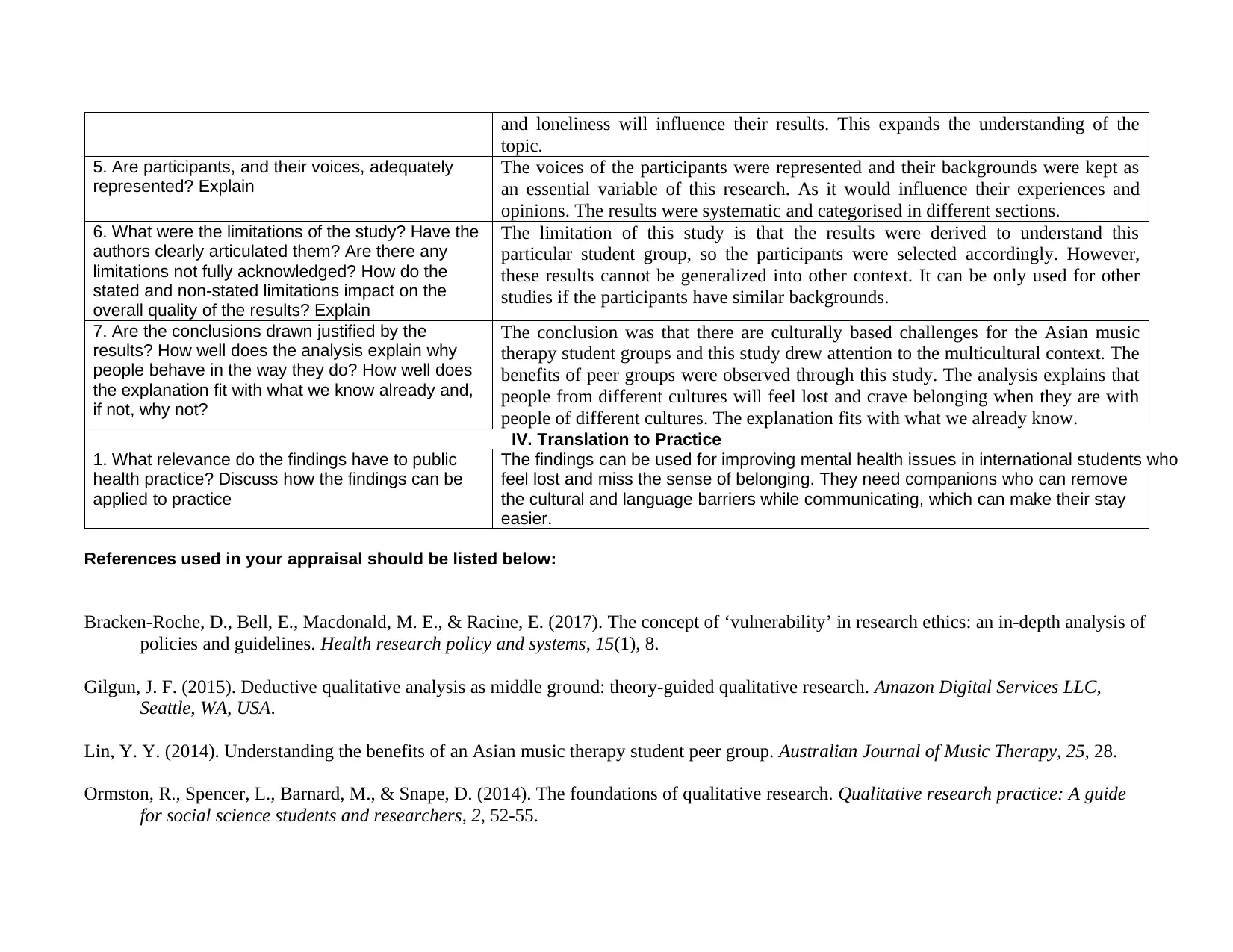
and loneliness will influence their results. This expands the understanding of the
topic.
5. Are participants, and their voices, adequately
represented? Explain
The voices of the participants were represented and their backgrounds were kept as
an essential variable of this research. As it would influence their experiences and
opinions. The results were systematic and categorised in different sections.
6. What were the limitations of the study? Have the
authors clearly articulated them? Are there any
limitations not fully acknowledged? How do the
stated and non-stated limitations impact on the
overall quality of the results? Explain
The limitation of this study is that the results were derived to understand this
particular student group, so the participants were selected accordingly. However,
these results cannot be generalized into other context. It can be only used for other
studies if the participants have similar backgrounds.
7. Are the conclusions drawn justified by the
results? How well does the analysis explain why
people behave in the way they do? How well does
the explanation fit with what we know already and,
if not, why not?
The conclusion was that there are culturally based challenges for the Asian music
therapy student groups and this study drew attention to the multicultural context. The
benefits of peer groups were observed through this study. The analysis explains that
people from different cultures will feel lost and crave belonging when they are with
people of different cultures. The explanation fits with what we already know.
IV. Translation to Practice
1. What relevance do the findings have to public
health practice? Discuss how the findings can be
applied to practice
The findings can be used for improving mental health issues in international students who
feel lost and miss the sense of belonging. They need companions who can remove
the cultural and language barriers while communicating, which can make their stay
easier.
References used in your appraisal should be listed below:
Bracken-Roche, D., Bell, E., Macdonald, M. E., & Racine, E. (2017). The concept of ‘vulnerability’ in research ethics: an in-depth analysis of
policies and guidelines. Health research policy and systems, 15(1), 8.
Gilgun, J. F. (2015). Deductive qualitative analysis as middle ground: theory-guided qualitative research. Amazon Digital Services LLC,
Seattle, WA, USA.
Lin, Y. Y. (2014). Understanding the benefits of an Asian music therapy student peer group. Australian Journal of Music Therapy, 25, 28.
Ormston, R., Spencer, L., Barnard, M., & Snape, D. (2014). The foundations of qualitative research. Qualitative research practice: A guide
for social science students and researchers, 2, 52-55.
topic.
5. Are participants, and their voices, adequately
represented? Explain
The voices of the participants were represented and their backgrounds were kept as
an essential variable of this research. As it would influence their experiences and
opinions. The results were systematic and categorised in different sections.
6. What were the limitations of the study? Have the
authors clearly articulated them? Are there any
limitations not fully acknowledged? How do the
stated and non-stated limitations impact on the
overall quality of the results? Explain
The limitation of this study is that the results were derived to understand this
particular student group, so the participants were selected accordingly. However,
these results cannot be generalized into other context. It can be only used for other
studies if the participants have similar backgrounds.
7. Are the conclusions drawn justified by the
results? How well does the analysis explain why
people behave in the way they do? How well does
the explanation fit with what we know already and,
if not, why not?
The conclusion was that there are culturally based challenges for the Asian music
therapy student groups and this study drew attention to the multicultural context. The
benefits of peer groups were observed through this study. The analysis explains that
people from different cultures will feel lost and crave belonging when they are with
people of different cultures. The explanation fits with what we already know.
IV. Translation to Practice
1. What relevance do the findings have to public
health practice? Discuss how the findings can be
applied to practice
The findings can be used for improving mental health issues in international students who
feel lost and miss the sense of belonging. They need companions who can remove
the cultural and language barriers while communicating, which can make their stay
easier.
References used in your appraisal should be listed below:
Bracken-Roche, D., Bell, E., Macdonald, M. E., & Racine, E. (2017). The concept of ‘vulnerability’ in research ethics: an in-depth analysis of
policies and guidelines. Health research policy and systems, 15(1), 8.
Gilgun, J. F. (2015). Deductive qualitative analysis as middle ground: theory-guided qualitative research. Amazon Digital Services LLC,
Seattle, WA, USA.
Lin, Y. Y. (2014). Understanding the benefits of an Asian music therapy student peer group. Australian Journal of Music Therapy, 25, 28.
Ormston, R., Spencer, L., Barnard, M., & Snape, D. (2014). The foundations of qualitative research. Qualitative research practice: A guide
for social science students and researchers, 2, 52-55.
⊘ This is a preview!⊘
Do you want full access?
Subscribe today to unlock all pages.

Trusted by 1+ million students worldwide
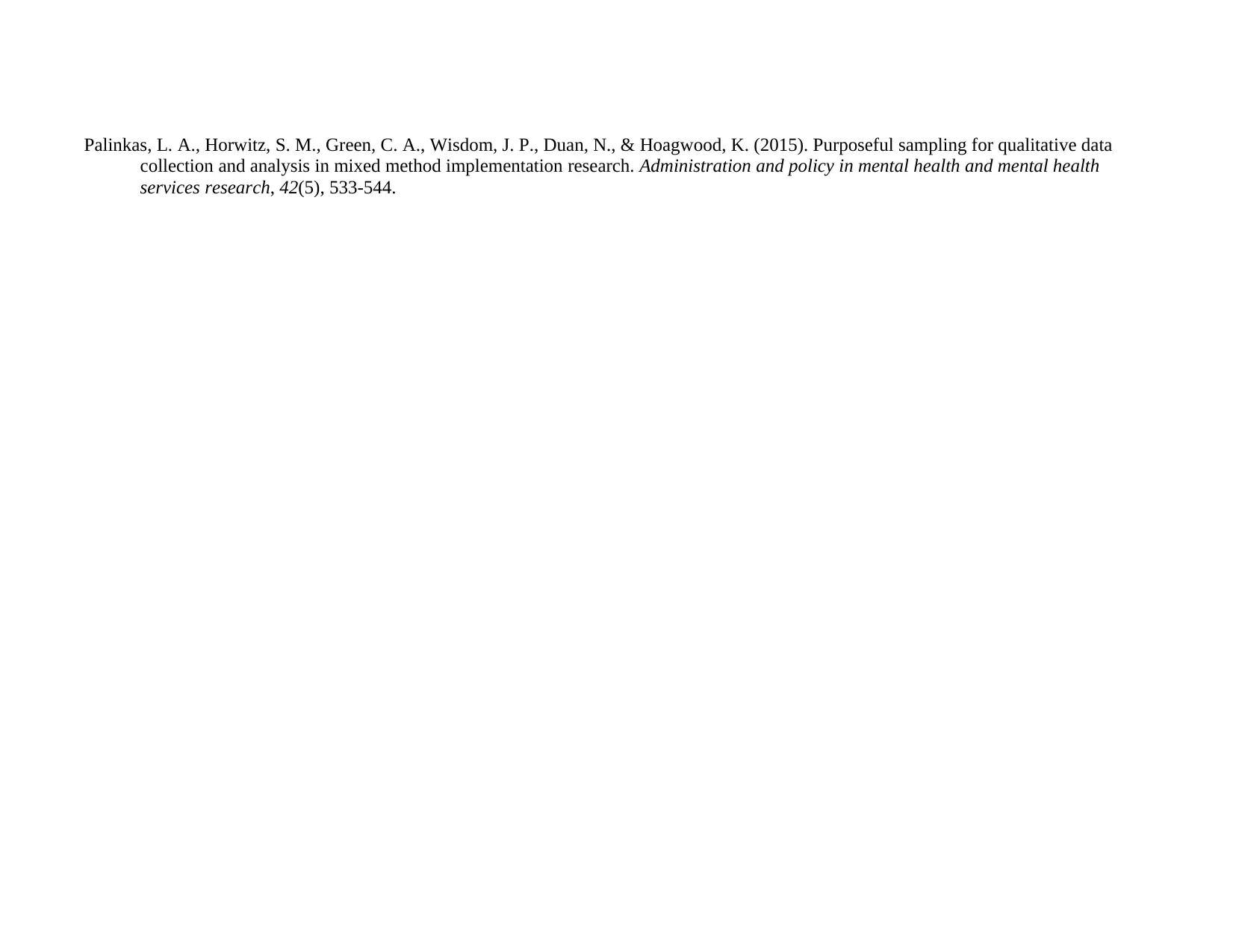
Palinkas, L. A., Horwitz, S. M., Green, C. A., Wisdom, J. P., Duan, N., & Hoagwood, K. (2015). Purposeful sampling for qualitative data
collection and analysis in mixed method implementation research. Administration and policy in mental health and mental health
services research, 42(5), 533-544.
collection and analysis in mixed method implementation research. Administration and policy in mental health and mental health
services research, 42(5), 533-544.
1 out of 7
Related Documents
Your All-in-One AI-Powered Toolkit for Academic Success.
+13062052269
info@desklib.com
Available 24*7 on WhatsApp / Email
![[object Object]](/_next/static/media/star-bottom.7253800d.svg)
Unlock your academic potential
Copyright © 2020–2025 A2Z Services. All Rights Reserved. Developed and managed by ZUCOL.





